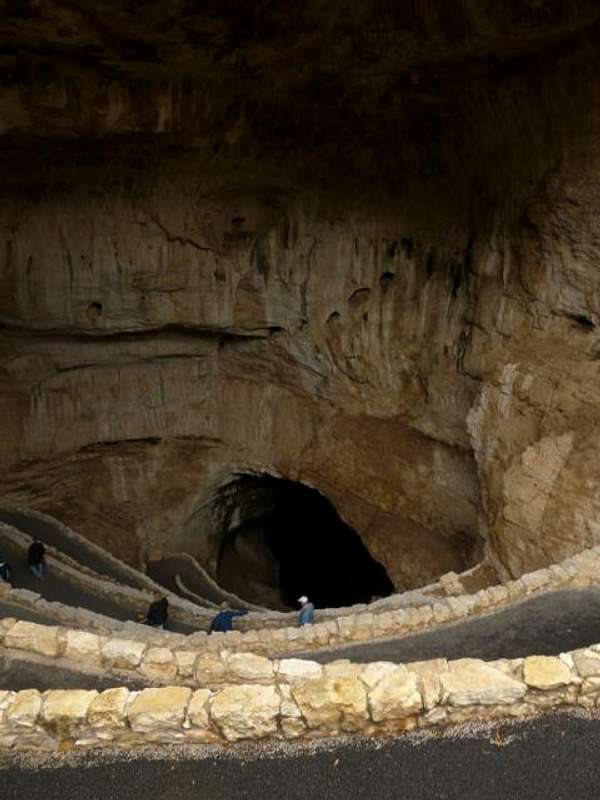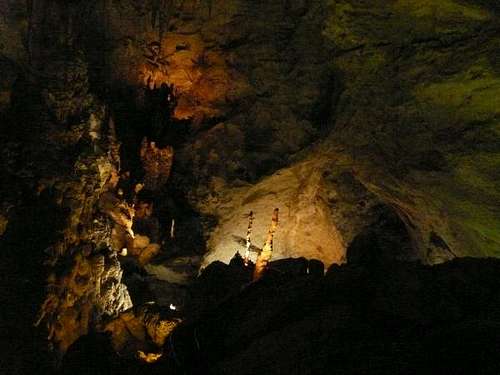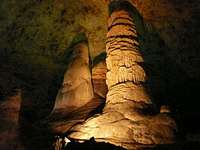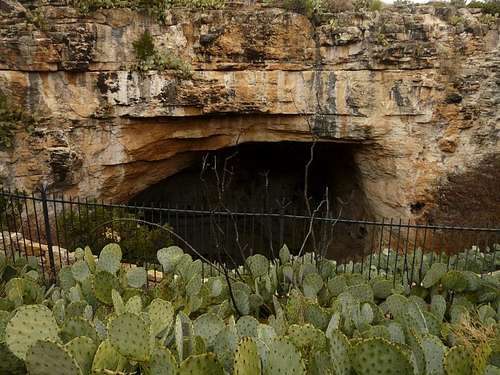|
|
Area/Range |
|---|---|
|
|
32.17646°N / 104.44201°W |
|
|
Hiking |
|
|
Spring, Summer, Fall, Winter |
|
|
6535 ft / 1992 m |
|
|
Introduction
So it's not a mountain range, isn't known for its hiking and is one of America's most visited national parks crowded with tourbuses and RVs. But that doesn't make it one bit less deserving of a place here than any other natural world heritage site.The park contains a total of 116 known caves. In addition to the main caverns, two of these, Slaughter Canyon and Spider Cave, are open to the general public with a guided tour. A few others may be explored by experienced cave-goers with a permit from the Visitor Center. The rest, including America's deepest limestone cave, Lechuguilla Cave (1604'), require a research permit to enter.
Directions
Carlsbad is the closest real city to the park and is about 20 miles away from Whites' City (not really a city) at the entrance to the park. From there, take the concurrent US 62-180 south to the sign for Carlsbad Caverns National Park. Turn right at the sign and drive 7 miles on Walnut Canyon Drive.The closest major city is El Paso, TX. From downtown, take US 62-180 east some 150 miles to Whites' City and turn left at the sign for Carlsbad Caverns National Park.
The turn for Slaughter Cave (and Rattlesnake Canyon) is a few miles to the south.
Going Under
There are two main options for touring the cave: guided or self-guided.For self-guided tours, pick up a handheld guide and head down the Natural Entrance (1.25 miles, +50'/-800' elevation change) to the Big Room (3rd largest chamber in the Americas) and the loop trail (1.25 miles, flat). Or just take the elevator down to the Big Room if you arrive late after 2:00 PM in winter or 3:30 in summer (Memorial Day to Labor Day). Elevators close at 3:30 in winter and 5:00 in summer. If you are able to, I HIGHLY recommend heading down the natural entrance. Tickets are $6 for anyone 16 or older and free for 15 and under. Valid for 3 days.
A guided tour is needed to go past the Big Room as well as to go into Slaughter Canyon Cave. Cost varies from $8 for Kings Palace to $20 for any of the Wild Cave tours. Anyone with reasonable experience in the mountains (along with many not) should be fine with the difficulty with all of these tours. Here is a list of tours and prices. Note that only a select few tours run on any given day. Reserve at least a few days if not a week in advance during holiday weekends.
Above Ground
To protect the caverns below means protecting the land above. And while it may not be as interesting as inside the cave, there is still much to see. And best of all, it comes without the crowds!The Desert Scenic Loop Road is the road that provides the link from the Visitor Center to the backcountry. It links to the Rattlesnake Canyon Trail which heads down Rattlesnake Canyon to the bottom of the mountain and ends at private property, a little disappointing but a good walk.
To get deeper into the Guadalupe Mountains, take the road to Slaughter Canyon past Rattlesnake Springs to the Slaughter Canyon Trailhead. Heading up the canyon will take you on top of Guadalupe Ridge and turns west. The trail ends at a rough dirt road which continues west at the park boundary into national forest land (Lincoln National Forest).
The highpoint of the national park is just off this dirt road. To reach it, continue west from the boundary to the top of the first hill (Point 6632). Look south, down the ridge and the point about a hundred feet lower in elevation is the highpoint (which happens to be exactly on a linear park boundary). Round-trip to the highpoint from Slaughter Canyon is about 16 miles. Alternatively, you can take the dirt road in from Lincoln National Forest (off the NM 317) but the road is quite rough and probably impassible for small vehicles. Round-trip this way is about 1 mile off-trail.
Backcountry camping is allowed by permit west of the Rattlesnake Canyon Trailhead (so everywhere with decent hiking). Permits and a list of restictions are found here.
Geology
Carlsbad Caverns sits on east end of the Guadalupe Mountains, a chain of mountains that stretches from a hundred miles to the north south through the park to abruptly terminate on the impressively sheer face of El Capitan sitting just below Guadalupe Peak, the highest mountain in Texas. This entire range was once part of a 400-mile long underwater reef called the Capitan Reef. It was part of a shallow inland sea during the Permian era about 250 million years ago. The sea eventually disappeared and the reef, buried with sediments. Just a few million years ago, mountain building lifted this land exposing the reef which is what makes neighboring Guadalupe Mountains National Park unique.The exposed reef, now turned into limestone, left an opportunity for rainwater to seep down. The rainwater, made acidic by the air and soil, meets the rock and corrodes it. Many geologists also believe that this rainwater, when in contact with the deposited salt left over from the ancient sea, becomes sulfuric acid speeding up the rate of erosion. Over time, these cracks grew into large, underground caverns.
As the dissolved-limestone water continues to drip through, they deposit tiny bits of limestone on the ceilings, walls and floors. These eventually grow into various cave formations giving them the decorated appearance they have. The process of cave-building can be seen on the Desert View Loop Drive where exposed limestone can be seen exhibiting cracks and holes which are essentially the first step in becoming a true cave.
Cave Formations
Carlsbad Caverns is filled with various different cave formations, or speleothems, which have grown during the last ice age. Due to the now desert climate, cave and formation growth is at a standstill and will remain so until the climate changes again.
Stalgmites, Stalactites and Columns
These form when dripping water, deposits dissolved calcite on the rocks which, over time, grow into long spires on the ceiling (stalactites) and on the floor (stalagmites). Over time, as these get longer, they meet and become a column.
Soda Straws
These are the early-stage stalactites. Water dripping from the ceiling deposits the calcite along the outside edge of the the drop creating a ring and, over time, a thin, hollow tube. When it gets plugged up by any particle, water backs up and fills the tube up with calcite and then is forced to flow on the outside of the formation to keep up the growing process as a stalactite.
Draperies
These formations look almost like a sheet hanging over the side of a bed. They are formed when water drips along a line on the ceiling (unlike for a stalactite, where water drips from a single point). These often have folds much like...draperies!
Helictites
Helictites are small, gravity defying formations which look somewhat like paperclips twisted into a wild shape and stuck into the rock. Their formation remains a mystery to geologists.
Popcorn
Popcorn looks exactly like what it sounds. These are bubbly formations on the rock which form when convection currents in the cavern air carrying moisture up deposits calcite on the rocks before heading back down to the floor to carry back up more.
More on Geology...
Biology
When first entering the caverns through the Natural Entrance, one the first things you may notice (beyond the enormous size) is the dripping of water. The same process which created the cave millions of years ago is still doing its job. That means water still exists even 800 feet down providing an environment thriving with life.Carlsbad Caverns is at the boundary of the Great Plains of theto the east and the mountainous lands of the west. It's also at the edge of the Chihuahan Desert which stretches deep into Mexico. These boundaries is important as it means that the area includes life from all regions. And while the surface IS a desert, the environment continues to support a large variety of both plant and animal species.
Flora
Cacti
The Chihuahan Desert includes a greater diversity of cacti than anywhere else on the planet for which Big Bend National Park is famous for. There are a total of 26 subspecies of cacti found within the national park. The cacti are everywhere but generally most abundant in the canyons or at the bottom of seemingly dry riverbeds.
Agaves, lechuguillas also grow and appear nearly everywhere in the lower elevations. Sotols are also found in the wetter areas like Rattlesnake Springs.
Trees and Shrubs
The eastern part of the area is all shrubland with species like the Pinchot juniper, mesquite and the cresote bush. Mulberry bushes also grow here and are very popular with the wildlife. Rattlesnake Springs sustains cottonwoods and willows in a riperian environment.
More on Trees and Shrubs...
Fauna
Bats
Each year during summer, countless numbers of Mexican free-tailed bats migrate into the cave from Mexico to breed. In the summer, daily at sundown, the park holds a Bat Flight Program to watch a mass exit of bats at the Bat Flight Amphitheater by the Natural Entrance. This generally begins around Memorial Day and winds down around Labor Day. Photography is not allowed at all in the amphitheater during this period. Early observers described the scene from a distance as looking like smoke.
More on the Bat Flight Program...
Birds
Over 350 species of birds have been identified in the park. The best place to find them is at Rattlesnake Spring, a permanent spring on the road to Slaughter Canyon.
More on Birds...
Cave Invertebrates
The invertebrates of the cave are more private and don't put on a show. In fact, it's quite rare that you will see one unless you get off on a wild cave tour. New species are continuously being discovered each year.
Like many other caverns, Carlsbad has cave crickets which feed on small insects, algae and fungi. They are an important part of the food chain and feed bats, raccoons and ringtails. Their waste and eggs also support a variety of other organisms. The three known species in the park are Ceuthophilus carlsbadensis, Ceuthophilus longipes and Ceuthophilus conicaudus.
Horsehair worms are also found in the cave. They are parasites of cave insects which live inside them until they die or are close to water.
More on the Invertebrates...
History
Who actually discovered the cave is disputed. The first to actually enter the cave is not; that would be then 16 year old Jim White who entered the cave in 1898. During his time, visitors entered the cave through guano buckets which were in place until the NPS installed a staircase in 1925. National Monument status was granted on October 23, 1923 with National Park status on May 23, 1930. The first elevator was completed in January of 1932. The cave was also the setting for "Journey to the Center of the Earth" which was filmed in the Kings Palace and Boneyard sections of the cave in 1959. The park finally becomes a World Heritage Site in December of 1995.More on History...











